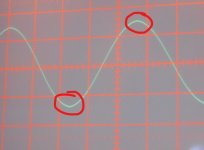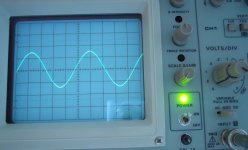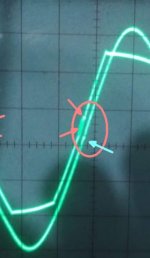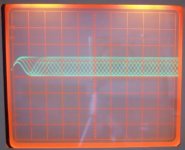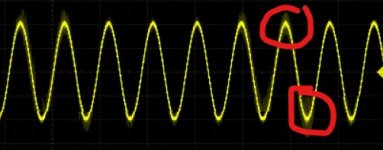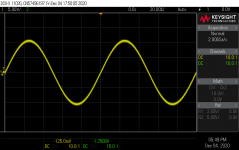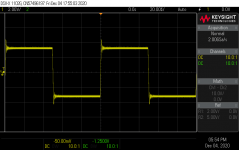I need to buy one of these units, and it is my first one so i need something that is suitable for new starters as well as being good enough to move forward with.
I am primarily going to use it, to start with anyway for amp/equipment repairs
I dont have a great deal of room at home so im looking for a bit of advice as to what might be best for me to purchase.
I would prefer to buy new, so i have a warrentee with it
cheers
I am primarily going to use it, to start with anyway for amp/equipment repairs
I dont have a great deal of room at home so im looking for a bit of advice as to what might be best for me to purchase.
I would prefer to buy new, so i have a warrentee with it
cheers
The op asks a really good question here and this is something I don't know the answer to having grown up always using analogue. I sometimes get asked on here 'what sort of scope should I buy' and I never know what to advise with regard to minimum specs.
I know where the op is coming from with this question so I have a few specific examples in analogue... so what would be needed with a digital scope to get close to this. All of these are dead easy for any analogue scope of even modest bandwidth such as a 10 or 20Mhz scope.
Image #1 and #2 are taken by me today and show a 1kHz synthesised 'sine' from a function generator. In real life on an analogue scope the distortion at the peaks is clearly visible. What sort of specs would you need in a digital scope to resolve that?
Image 3 is from the web and shows what looks like a small amount of HF oscillation around a zero crossing point. What sort of spec would be needed for that?
Image 4 is the classic RF or eye pattern found in CD players. This is one of mine from a long time ago. Again, what sort of minimum spec would be needed for something like that with a digital scope?
As I say, I've grown up with and continue to use analogue (at the moment anyway ) and don't really know the answers to this.
) and don't really know the answers to this.
I know where the op is coming from with this question so I have a few specific examples in analogue... so what would be needed with a digital scope to get close to this. All of these are dead easy for any analogue scope of even modest bandwidth such as a 10 or 20Mhz scope.
Image #1 and #2 are taken by me today and show a 1kHz synthesised 'sine' from a function generator. In real life on an analogue scope the distortion at the peaks is clearly visible. What sort of specs would you need in a digital scope to resolve that?
Image 3 is from the web and shows what looks like a small amount of HF oscillation around a zero crossing point. What sort of spec would be needed for that?
Image 4 is the classic RF or eye pattern found in CD players. This is one of mine from a long time ago. Again, what sort of minimum spec would be needed for something like that with a digital scope?
As I say, I've grown up with and continue to use analogue (at the moment anyway
Attachments
Yeah, the OP asked for a new oscilloscope, analogue or digital. AFAIK the only new analogue ones that aren't crazy expensive are of the 'cheap and cheerful' variety.
IMO, both have a purpose and there's not really any need to choose if you can have both. Buy a workable new digital oscilloscope (I have a Siglent 1202X-E) and then get an old analogue one for £40.
The only consideration is space; the OP mentions they do not have a lot of it.
IMO, both have a purpose and there's not really any need to choose if you can have both. Buy a workable new digital oscilloscope (I have a Siglent 1202X-E) and then get an old analogue one for £40.
The only consideration is space; the OP mentions they do not have a lot of it.
Space is always an issue with analogue because of the length of the CRT.
If space concerns and having set your heart on digital means you are going to buy digital... it's what minimum spec is needed and what to expect from it.
For example what would you need to cover the screenshots I posted. Would a 20Mhz digital get you close or not?
There is the old 'rule of five' that says you need a bandwidth five times higher than the max sine wave type signal you want to measure (if you want to get amplitude accuracy).
It would be great if someone had some actual images of signals displayed on digital scopes (such as CD eye pattern) to get a feel of what sort of minimum specs are needed.
If space concerns and having set your heart on digital means you are going to buy digital... it's what minimum spec is needed and what to expect from it.
For example what would you need to cover the screenshots I posted. Would a 20Mhz digital get you close or not?
There is the old 'rule of five' that says you need a bandwidth five times higher than the max sine wave type signal you want to measure (if you want to get amplitude accuracy).
It would be great if someone had some actual images of signals displayed on digital scopes (such as CD eye pattern) to get a feel of what sort of minimum specs are needed.
Up until very recently (last year?) you could get 20MHz analogue / CRT scopes from Rapid Electronics (Taiwan-made), and I think RS (haven't checked recently) also sold a similar scope with their own branding. They are quite nice scopes (had one and gave it to a friend), but you'd be mad to pay the £400 price they were selling it at. I think they were being sold to colleges who needed analogue for some reason.
£400 will buy you a serious analogue scope secondhand.
£400 will buy you a serious analogue scope secondhand.
It's a bit apples-to-oranges, though. Any decent benchtop scope will do audio ranges -- it would be hard to get one that doesn't! (Avoid the USB ones!)
If you're working in analogue signals, an analogue oscilloscope will usually look better. If you're only concerned with a primary bandwidth of 20Hz - 20kHz, then a very simple 10MHz scope will do it, even when multiplying by 5. I use an analogue scope when I want to accurately visualize a signal, since it is very easy to work with and understand what is going on. This is good for a constant signal (a sine wave, for example) but it's much harder to make sense of a constantly changing signal.
A digital scope has to do an additional step of sampling and digitizing the signal before displaying it. These are generally very fast -- my Siglent is 1 GSa/s with 200MHz bandwidth. (It's also relatively cheap, about £300.) As a consequence I find the digital scope almost always looks noisier than an analogue scope. I think this comes down to the difference between accuracy and precision: Both scopes are accurate, but the digital scopes are more precise.
Having digitized the sample, though, you can do lots of different types of processing. Saving, averaging, measuring, printing, math, etc. These can be more or less important; it's up to you to decide.
Two different tools, two different uses. No one is better than the other.
So:
- If you really want new, digital is the only viable option. Rigol or Siglent make good entry-level scopes
- If you're ok with used, and want analogue, get a good Tek or HP from the 1980s-1990s. £400 is more than enough. Resist the romantic urge to buy the older Tek scopes from the 60s and 70s; they can be good but some of the parts are unobtanium!
- The best is to have both, which you can probably do on your budget.
If you're working in analogue signals, an analogue oscilloscope will usually look better. If you're only concerned with a primary bandwidth of 20Hz - 20kHz, then a very simple 10MHz scope will do it, even when multiplying by 5. I use an analogue scope when I want to accurately visualize a signal, since it is very easy to work with and understand what is going on. This is good for a constant signal (a sine wave, for example) but it's much harder to make sense of a constantly changing signal.
A digital scope has to do an additional step of sampling and digitizing the signal before displaying it. These are generally very fast -- my Siglent is 1 GSa/s with 200MHz bandwidth. (It's also relatively cheap, about £300.) As a consequence I find the digital scope almost always looks noisier than an analogue scope. I think this comes down to the difference between accuracy and precision: Both scopes are accurate, but the digital scopes are more precise.
Having digitized the sample, though, you can do lots of different types of processing. Saving, averaging, measuring, printing, math, etc. These can be more or less important; it's up to you to decide.
Two different tools, two different uses. No one is better than the other.
So:
- If you really want new, digital is the only viable option. Rigol or Siglent make good entry-level scopes
- If you're ok with used, and want analogue, get a good Tek or HP from the 1980s-1990s. £400 is more than enough. Resist the romantic urge to buy the older Tek scopes from the 60s and 70s; they can be good but some of the parts are unobtanium!
- The best is to have both, which you can probably do on your budget.
An SDS1104 owner here, configured for 200MHz with all the features. I've used basic analogue scopes many years ago as my Dad was into electronics and would bring home a scope on the weekends. Size of the 1104 was part of the reason for me too - it fits on a bookshelf unlike the analogue scopes I've used in the past!
A scope is a microscope and the ways you use/get the best out of digital or analogue differ.
Analogue will give you immediate infinite resolution realtime capabilities. The triggering and speed will be faster than a digital scope in displaying.
Digital, at this price range, gives you what's on the screen and that resolution is 8bit with some offset and scaling. The 1104 does start to slow once you start creating larger acquisition of data. Think more 'capture, process then display'. It takes a little getting used to - but a digital tends to have more features in t he triggering and maths.
Slightly annoying with the 1104 is that you can't do compound maths - for example use the four probes for maths as most of the maths functions only operate on two channels and you only have one maths function. You can still use the two other channels when using maths but not apply a second maths function to those channels.
What you will find is that frequency analysis is also important if you're designing and repairing so a spectrum analyser is useful but those can be created from a sound card. The FFT does work in the 1104, it gives a good finger in the air and you can zoom in etc but as people have indicated the bit resulution of the scope (fast rate low resolution) vs an analyser (slow rate, high resolution and wide spectrum) will start becoming apparent. However it's good enough in the most for audio to help diagnose a problem or two.
Lastly - function generation is useful. Most scopes at this price range don't come with a AWG inbuilt. If you want to bode test on the scope for example you will need something to make the noise as instructed by the scope. More expensive scopes have basic generators built in. You can pick these up for 100 or less but I would have it scope controllable.
From my limited experience I quickly found the 8bit resolution limits but you will need to plan around those a little. If you're doing power/tube amps then you will need a higher voltage probe in your budget. A 100x or 1000x. So digital definitely does have limits in terms of resolution and you'll not see between the samples, but it also has the advantage of being ~80% of usefulness for 20% of the size and weight. Also sample rate - 1Gs/sec but as you add channels and maths this rate drops so you may not see with the full resolution any issues that analogue may show. Precision but only if that issue and the sampling period collide so less samples means you need to think a little if you're trying to detect some issue or so.
I just worked out this morning how to get cursors to work with maths function output:
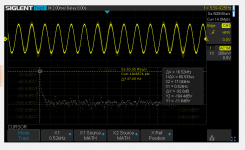
A scope is a microscope and the ways you use/get the best out of digital or analogue differ.
Analogue will give you immediate infinite resolution realtime capabilities. The triggering and speed will be faster than a digital scope in displaying.
Digital, at this price range, gives you what's on the screen and that resolution is 8bit with some offset and scaling. The 1104 does start to slow once you start creating larger acquisition of data. Think more 'capture, process then display'. It takes a little getting used to - but a digital tends to have more features in t he triggering and maths.
Slightly annoying with the 1104 is that you can't do compound maths - for example use the four probes for maths as most of the maths functions only operate on two channels and you only have one maths function. You can still use the two other channels when using maths but not apply a second maths function to those channels.
What you will find is that frequency analysis is also important if you're designing and repairing so a spectrum analyser is useful but those can be created from a sound card. The FFT does work in the 1104, it gives a good finger in the air and you can zoom in etc but as people have indicated the bit resulution of the scope (fast rate low resolution) vs an analyser (slow rate, high resolution and wide spectrum) will start becoming apparent. However it's good enough in the most for audio to help diagnose a problem or two.
Lastly - function generation is useful. Most scopes at this price range don't come with a AWG inbuilt. If you want to bode test on the scope for example you will need something to make the noise as instructed by the scope. More expensive scopes have basic generators built in. You can pick these up for 100 or less but I would have it scope controllable.
From my limited experience I quickly found the 8bit resolution limits but you will need to plan around those a little. If you're doing power/tube amps then you will need a higher voltage probe in your budget. A 100x or 1000x. So digital definitely does have limits in terms of resolution and you'll not see between the samples, but it also has the advantage of being ~80% of usefulness for 20% of the size and weight. Also sample rate - 1Gs/sec but as you add channels and maths this rate drops so you may not see with the full resolution any issues that analogue may show. Precision but only if that issue and the sampling period collide so less samples means you need to think a little if you're trying to detect some issue or so.
I just worked out this morning how to get cursors to work with maths function output:

Last edited:
That's useful Nick. Your showing only 500Hz there and the sampling is very clear to see if you look closely.
Also what are all the other things. On analogue you would look at that and say the signal source had HF instability but I'm guessing here those are display/sampling artefacts and not present in the original... or am I wrong on that?
If that sine were at say 50kHz or 500kHz would it look even more 'quantised' or not?
For a beginner I think analogue will teach you more because you have to question and work out what you are seeing, which takes only seconds with a calculator for frequency for example.
Also what are all the other things. On analogue you would look at that and say the signal source had HF instability but I'm guessing here those are display/sampling artefacts and not present in the original... or am I wrong on that?
If that sine were at say 50kHz or 500kHz would it look even more 'quantised' or not?
For a beginner I think analogue will teach you more because you have to question and work out what you are seeing, which takes only seconds with a calculator for frequency for example.
Attachments
I love my Keysight DSOX1102. I still have my TEK 2465B, but it sits on a storage shelf rather than on the equipment shelf above the lab bench.
I think either will teach a beginner many things as long as the beginner doesn't develop a habit of hitting the autoset button every time the image on the scope doesn't make sense.
Tom
I think either will teach a beginner many things as long as the beginner doesn't develop a habit of hitting the autoset button every time the image on the scope doesn't make sense.
Tom
As I work in analogue audio, I'd say that my ideal scope would be an analogue one, but with the various measurement and storage functions that you'd get with a digital one! I have both types next to each other. 99% of the time, my daily driver is the digital. But there are occasions where only analogue will do (I presume an extremely expensive digital one might do as well). Update rate is your enemy on digital, particularly budget scopes. An analogue scope will enable you to see some transient events in real-time, without having to resort to using one-shot storage. In realtime monitoring, a digital might miss these transients altogether due to update rate / lag.
If there are spurious or jittery artefacts present in an analague signal, this can make some tasks almost impossible with a digital scope. For example: if you work with analogue tape machines, an analogue scope is a must.
If there are spurious or jittery artefacts present in an analague signal, this can make some tasks almost impossible with a digital scope. For example: if you work with analogue tape machines, an analogue scope is a must.
Last edited:
Update rate is your enemy on digital, particularly budget scopes.
Yep. I seem to recall that being one of the factors that pushed me towards the Keysight.
An analogue scope will enable you to see some transient events in real-time, without having to resort to using one-shot storage. In realtime monitoring, a digital might miss these transients altogether due to update rate / lag.
OTOH, if that transient event only happens once in a blue moon, you will miss it if you're using an analog scope unless you just happen to glance at the screen at the right time. Some of the better digital scopes have triggers that'll trigger on "weird stuff", including glitches. In those cases the digital scope would be a lifesaver. Pattern triggers can be handy for debugging communication issues between ICs. That's another digital-only feature.
Tom
For example what would you need to cover the screenshots I posted. Would a 20Mhz digital get you close or not?
Bandwidth is not by itself a sufficient spec. Generally speaking, the more expensive models of top of the line brands can do more than discount-brand entry level products. That's for a whole variety of reasons. Stuff like acquisition modes, signal averaging modes, trigger modes, sample rates, vertical resolution verses sample rate, vertical bandwidth, memory depth, DSP speed (to reduce missing potential trigger events between sweeps due to signal processing deadtime, etc.), signal analysis firmware features, and so on.
Then there are active probes, differential probes, current probes, etc.
Just like it always was in the heyday of industry standard 100MHz, 2-channel, Tek analog scopes, the good stuff is still expensive relative to the value of money at the time.
Last edited:
and to complicate things further: my digital Tek 100MHz scope (approx 15 yrs old) has gone caput, whereas my numerous analogue scopes from the mid 70s are going strong. If you look at some of the monster analogue scopes from the late 70s and 80s, it's the digital functions that go t*ts up, not the analogue ones! As a rule, the more analogue a scope is, the longer it'll go before needing a repair. Hameg, Tek, Kenwood (and other Japanese) scopes tend to work indefinitely. I wouldn't place a bet on many modern scopes working in 15 years time.
Instek (Taiwan) offer a lifetime guarantee on their scopes now. I have one. Compared to the Tek, it doesn't have the ergonomics (that's where Tek score). But it works, which is more than I can say for the digital, Chinese-made Tek. If you want a Tek that's not made in China (current model), be prepared to remortgage.
Instek (Taiwan) offer a lifetime guarantee on their scopes now. I have one. Compared to the Tek, it doesn't have the ergonomics (that's where Tek score). But it works, which is more than I can say for the digital, Chinese-made Tek. If you want a Tek that's not made in China (current model), be prepared to remortgage.
Last edited:
Thanks Tom, those are great. Just posting this for reference having found it. Its for the Keysight:
https://www.farnell.com/datasheets/...221.453228295.1594006635-611634051.1579231713
The Keysight I would call a kind of upper midrange product... a very nice scope but how do you think those two images of yours might look on a 20Mhz budget type scope which is what a lot of beginners look at.
but how do you think those two images of yours might look on a 20Mhz budget type scope which is what a lot of beginners look at.
Something like this:
https://cpc.farnell.com/multicomp-pro/mp720009-eu-uk/digital-storage-oscilloscope-20mhz/dp/IN08384
https://www.farnell.com/datasheets/...221.453228295.1594006635-611634051.1579231713
The Keysight I would call a kind of upper midrange product... a very nice scope
Something like this:
https://cpc.farnell.com/multicomp-pro/mp720009-eu-uk/digital-storage-oscilloscope-20mhz/dp/IN08384
Attachments
- Home
- Design & Build
- Equipment & Tools
- oscilloscope-Analog or digital
